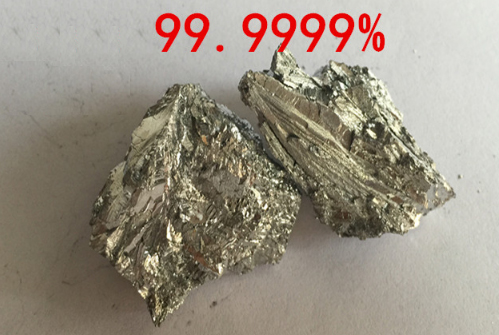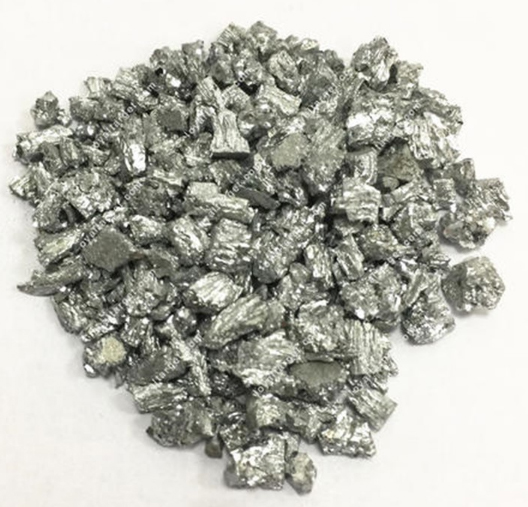99.99% and 99.999% and 99.9999% Antimony Pure Metal Ingot
Antimony is a semimetal in terms of its properties, that is, it
exhibits metallic and non-metallic properties. Semi-metals also include
silicon, boron, germanium, arsenic and tellurium. Antimony as a simple
substance is known in several allotropic modifications, of which the
most stable is crystalline - brittle silvery-white crystals with a
metallic luster. The density of this antimony is 6.68 kg / dm^3, the
melting point is 630.5 ° C, and the boiling point is 1635 ° C. Other
modifications are unstable under standard conditions and easily
(sometimes with an explosion) transform into crystalline antimony.
Liquid antimony expands during solidification (bismuth and gallium have
the same property), while ingots are easy to split, antimony practically
does not lend itself to forging. According to its magnetic properties,
it belongs to diamagnets.
Antimony is increasingly used in the semiconductor industry in the
production of diodes and infrared detectors, as well as in the
production of thermoelectric materials. For example, it can be used as a
dopant for semiconductors (electron donor): the addition of antimony to
germanium gives it certain semiconducting properties. Some antimonides
(aluminum, gallium, indium) also belong to semiconductor materials.
Antimony telluride Sb2Te3 is used as a component of thermoelectric
alloys with bismuth telluride. These areas also require a high purity of
antimony, in some cases a purity of 6N (99.9999%) is required
Antimony is a part of a large number of industrial alloys (more than two
hundred are known) as an alloying additive. Thus, the introduction of
antimony into the alloy increases its hardness, wear resistance, and
oxidation resistance. The most common are the following: bearing metals,
gartble, printing metal.
Bearing metals are alloys of antimony with lead, tin and copper,
sometimes also with bismuth and zinc. Babbits, the most common of them,
contain from 4% to 15% antimony and are intended for use as a layer,
cast or sprayed on the shell of the plain bearing shell. Thus, the field
of application of bearing metals is very wide: the automotive industry,
machine tools, and railroad transport.
The property of antimony to expand from a liquid to a solid state is
used in printing metal (mainly composed of antimony, lead and tin): the
addition of antimony makes it possible to obtain clear prints, as well
as to increase impact resistance, wear resistance and hardness. Lead
with the addition of antimony is used to make bullets and shrapnel,
battery plates (antimony content 5-15%).
Other areas of application of antimony and its compounds: production of
ceramics, dyes, special glasses (oxides, sulfides and antimony
trichloride), refractory materials (antimony (III) oxide), medicine and
cosmetics, production of matches (antimony (III) sulfide). Antimony
petafluoride in a mixture with hydrogen fluoride and / or other strong
acids is used to create a super acidic medium in fine organic synthesis
and research.
Antimony is moderately toxic, while trivalent antimony compounds are
more dangerous. Poisoning can be caused by dust or vapors of compounds,
the maximum concentration limit of aerosol in the air of the working
area is 0.0005 mg / l.
.



99.9999%, (6N)Antimony Pieces
99.999%, (5N)Antimony
Pieces
99.99%, (4N)Antimony
Antimony is a semimetal in terms of its properties, that is, it
exhibits metallic and non-metallic properties. Semi-metals also include
silicon, boron, germanium, arsenic and tellurium. Antimony as a simple
substance is known in several allotropic modifications, of which the
most stable is crystalline - brittle silvery-white crystals with a
metallic luster. The density of this antimony is 6.68 kg / dm^3, the
melting point is 630.5 ° C, and the boiling point is 1635 ° C. Other
modifications are unstable under standard conditions and easily
(sometimes with an explosion) transform into crystalline antimony.
Liquid antimony expands during solidification (bismuth and gallium have
the same property), while ingots are easy to split, antimony practically
does not lend itself to forging. According to its magnetic properties,
it belongs to diamagnets.
Antimony is increasingly used in the semiconductor industry in the
production of diodes and infrared detectors, as well as in the
production of thermoelectric materials. For example, it can be used as a
dopant for semiconductors (electron donor): the addition of antimony to
germanium gives it certain semiconducting properties. Some antimonides
(aluminum, gallium, indium) also belong to semiconductor materials.
Antimony telluride Sb2Te3 is used as a component of thermoelectric
alloys with bismuth telluride. These areas also require a high purity of
antimony, in some cases a purity of 6N (99.9999%) is required
Antimony is a part of a large number of industrial alloys (more than two
hundred are known) as an alloying additive. Thus, the introduction of
antimony into the alloy increases its hardness, wear resistance, and
oxidation resistance. The most common are the following: bearing metals,
gartble, printing metal.
Bearing metals are alloys of antimony with lead, tin and copper,
sometimes also with bismuth and zinc. Babbits, the most common of them,
contain from 4% to 15% antimony and are intended for use as a layer,
cast or sprayed on the shell of the plain bearing shell. Thus, the field
of application of bearing metals is very wide: the automotive industry,
machine tools, and railroad transport.
The property of antimony to expand from a liquid to a solid state is
used in printing metal (mainly composed of antimony, lead and tin): the
addition of antimony makes it possible to obtain clear prints, as well
as to increase impact resistance, wear resistance and hardness. Lead
with the addition of antimony is used to make bullets and shrapnel,
battery plates (antimony content 5-15%).
Other areas of application of antimony and its compounds: production of
ceramics, dyes, special glasses (oxides, sulfides and antimony
trichloride), refractory materials (antimony (III) oxide), medicine and
cosmetics, production of matches (antimony (III) sulfide). Antimony
petafluoride in a mixture with hydrogen fluoride and / or other strong
acids is used to create a super acidic medium in fine organic synthesis
and research.
Antimony is moderately toxic, while trivalent antimony compounds are
more dangerous. Poisoning can be caused by dust or vapors of compounds,
the maximum concentration limit of aerosol in the air of the working
area is 0.0005 mg / l.
.
|
|
|
|
| 99.9999%, (6N)Antimony Pieces | 99.999%, (5N)Antimony Pieces | 99.99%, (4N)Antimony |
